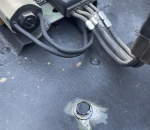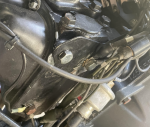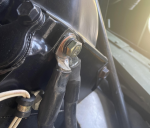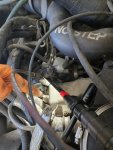I recently went through and cleaned up all my grounds. That spot on the firewall near the heater controls was the only one where I added a supplemental ground back to the engine. It had paint on both sides of the firewall and I did my best to get down to bare metal, it's a tough spot. I'm surprised it was functioning as a ground at all with the thick paint. Figured it was worth adding the extra ground here since I don't want to mess with it again if it can be avoided. I also pulled the grounds to each guage and cleaned/greased them, but I don't think they needed it.
View attachment 862077
The only other spot I may add a supplemental ground is at the control box since that's also kind of a crappy body connection (as I understand it). I just took off paint down to bare metal for now. If the control box housing is really the only source of ground for the box, that's a pretty crap-tacular design on such a critical/expensive component. Is there really not a dedicated ground connection coming in through the plug?
View attachment 862079
For these things that are grounded to the body (behind dash and control box), is there a ground strap between the body and engine somewhere? What is the primary path of ground from battery to body shell?
Looking at the previous posts on the Kascar kit, I don't plan to do the supplemental grounds from starter and alternator to the motor. I'm not sure I understand the purpose and it could be dangerous. The starter and alternator already have robust ground connections to the motor. I cleaned the alternator ground strap connections and starter, but don't understand of adding another less substantial connection. For high draw stuff like the alternator and starter, the last thing you want is all those amps running through an unfused 8 guage wire, it would quickly turn into a red hot heating element if the primary ground path had an issue.
Also, I redid all the grounds on the back of my motor and in the battery box. My truck doesn't have any signs of rust or corrosion, but it was a 2009 refurb and they were very generous with the black paint everywhere. Whoever reassembled the motor and connected the grounds did a lousy job of cleaning the paint off and making a good ground point. I cleaned bolts, cleaned up connections and mating surfaces and slathered on some dielectric grease. I pulled that bracket off the head and took the engine and bracket down to bare metal between them. Probably not needed with the current able to go through the bolt, but it never hurts to lower the resistance a bit.
View attachment 862080
View attachment 862081










